Are you struggling to connect with your new preschoolers? Unsure how to break the ice during the first week of class? Worried your students might feel overwhelmed or shy in a new environment? Still hunting for creative, meaningful activities that go beyond basic coloring sheets?
The answer is simple: all about me preschool projects. These projects not only help children build self-confidence and express their identity, but also help teachers establish warm, inclusive classroom environments—right from Day 1. These activities allow young learners to talk about themselves, their families, and their preferences through art, games, and interactive lessons. It’s more than just a fun craft—it’s a meaningful learning opportunity that supports social-emotional development, language growth, and a strong classroom community. For educators, it’s a practical and impactful way to kickstart the school year on a personal and positive note.
Children love talking about themselves—and when they get the chance to turn those conversations into colorful crafts and engaging stories, learning becomes magical. Let’s explore 10 of the most impactful, fun, and easy-to-implement all about me preschool projects that will transform your classroom and connect your kids deeply with each other.
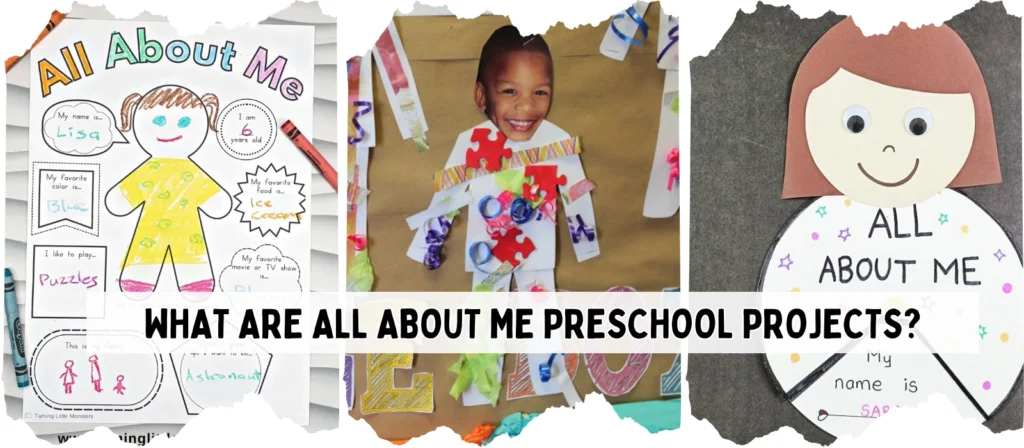
What Are All About Me Preschool Projects?
All about me preschool projects are structured learning activities that center around one key theme: the child. These projects provide an intentional and developmentally appropriate opportunity for preschoolers to explore their identity—who they are, what they like, where they come from, and who is important in their lives. Whether through art, writing, dramatic play, or hands-on activities, the goal is always to help children build self-awareness, celebrate individuality, and develop confidence in expressing themselves.
These activities typically involve creative tasks like making posters, drawing self-portraits, crafting family trees, or compiling small books about each child’s favorite things. Through these exercises, children engage with fundamental learning domains including language development, fine motor skills, emotional intelligence, and social skills. Teachers benefit as well—they gain insight into each child’s background, learning style, and preferences, making it easier to create inclusive and responsive classroom experiences.
From a curriculum perspective, all about me preschool projects fit seamlessly into early childhood education frameworks. They’re often used during the first few weeks of school to build relationships and create a sense of community, but their impact extends far beyond the start of the year. These projects foster classroom conversations, encourage active listening, and provide an early foundation for topics like diversity, empathy, and communication. In essence, they’re the perfect blend of meaningful content and joyful creativity.
Core Benefits of “All About Me” Projects in Preschool Classrooms
All about me preschool projects offer numerous developmental and instructional benefits that go beyond just creative expression. These projects are powerful tools for nurturing essential life skills and building foundational classroom relationships.
1. Faster Student Insight for Teachers
These projects allow educators to gather personal information about students’ backgrounds, preferences, and needs in an engaging, non-intrusive way. A simple poster or drawing can tell a teacher volumes about a child’s home life or emotional comfort level.
2. Boost in Self-Confidence and Identity
Young children begin to understand that they are unique, valuable individuals. This boost in self-identity is crucial during the early years, and it lays the groundwork for confident learning and positive behavior.
3. Encouragement of Language and Social Skills
All about me preschool projects naturally lead to storytelling, presentations, and group discussions. Children build vocabulary, improve sentence formation, and practice respectful listening—all through conversations about themselves.
4. Foundation for Thematic Curriculum Units
Many teachers use all about me preschool projects as a starting point for deeper themes like family structures, cultural heritage, emotions, and daily routines. These topics are ideal for branching into social-emotional learning, literacy, and STEM.
5. Sense of Belonging
When every child has a space to share their world, classrooms become communities. This feeling of connection reduces anxiety, supports behavior management, and encourages cooperation.
Top 10 All About Me Preschool Projects That Spark Creativity
All about me preschool projects are more than just colorful crafts—they are powerful identity-building tools that lay the foundation for social and emotional learning. These hands-on activities make learning highly personal and relevant, helping preschoolers see themselves as valued members of the classroom community. Whether you’re introducing a student to peers or encouraging self-expression through art, these top 10 all about me preschool projects will help every child feel recognized, respected, and proud to share their story.
1. Collage Self-Portrait
One of the most classic and effective all about me preschool projects is the self-portrait collage. Using magazines, colored paper, yarn, buttons, and more, children can create a mixed-media representation of themselves. Teachers can provide a blank face template or let children cut and shape their own facial features.
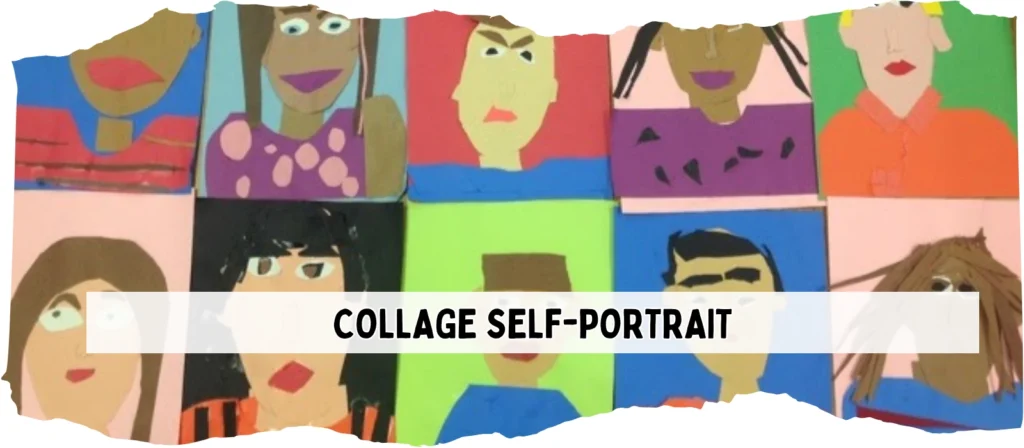
Age Range: 3–5 years
Materials Needed: Construction paper, scissors, glue sticks, yarn, fabric scraps, markers, crayons, safety mirrors
Learning Objectives:
- Identify facial features and their positions
- Improve fine motor skills through cutting and gluing
- Encourage self-reflection and body awareness
This activity can be expanded by inviting children to describe their portraits in a group circle, fostering oral language development and peer appreciation.
2. My Family Tree
This heartfelt project allows children to share who is in their family and how they are connected. Each child creates a simple family tree using drawings, photos from home, or printable templates. This can be displayed in the classroom, prompting conversations about family diversity and love.

Age Range: 4–5 years
Materials Needed: Poster board, family photos or printable cutouts, glue, markers, pre-printed tree templates (optional)
Learning Objectives:
- Understand family structure and vocabulary (mother, brother, cousin, etc.)
- Build emotional connections between home and school
- Develop sequencing and categorization skills
Tip: Add a take-home letter asking parents to help supply photos. It’s a great way to involve families from the start.
3. Handprint Identity Project
This sensory-rich activity has children trace or stamp their hands on paper and fill the inside with things that represent them—favorite foods, colors, toys, or even emotions. They can draw, use stickers, or collage items that feel personal.
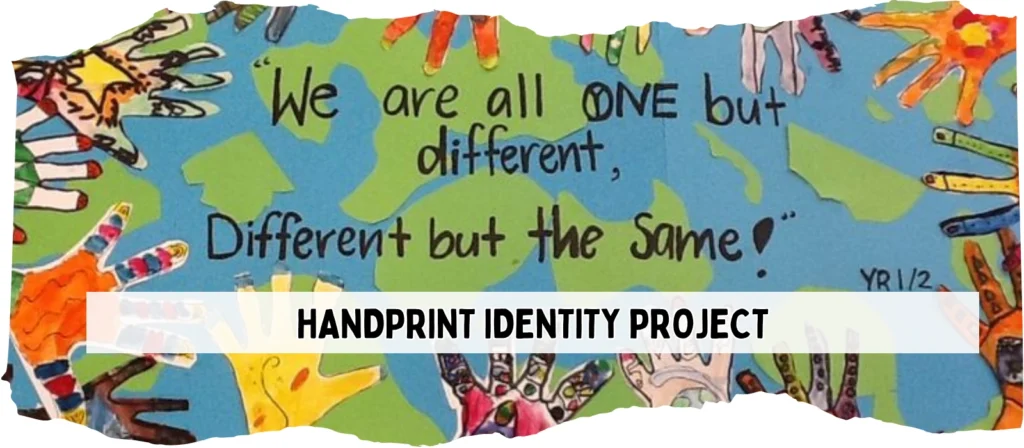
Age Range: 3–5 years
Materials Needed: Paint, markers, paper, stickers, glue, hand tracing template (optional)
Learning Objectives:
- Strengthen self-awareness and expression
- Introduce early symbolic representation
- Practice patterning, labeling, and storytelling
This project can be grouped together on a classroom wall to create a colorful visual of each child’s uniqueness.
4. Face Puzzle Craft
Give each child a large photo of themselves (or have them draw their face), and then cut it into puzzle pieces. Children reassemble the puzzle to “put themselves together,” offering a symbolic and physical activity that supports problem-solving and identity reinforcement.
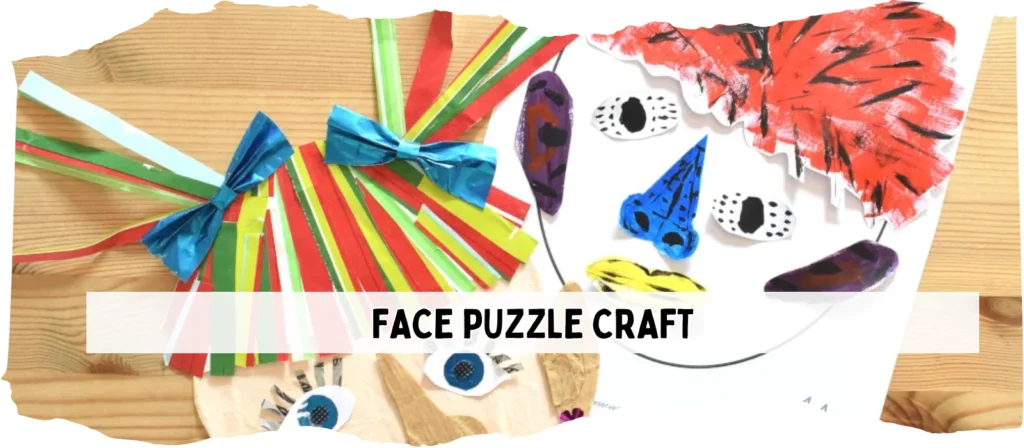
Age Range: 4–6 years
Materials Needed: Printed or drawn faces, scissors, envelopes or Ziploc bags
Learning Objectives:
- Encourage fine motor coordination
- Support personal identity and recognition
- Practice spatial awareness and sequencing
You can laminate the puzzles and place them in a learning center for ongoing self-directed play.
5. Name Art with Stamps
Names are powerful. This project turns each child’s name into an art piece using alphabet stamps, stickers, or even natural objects like leaves and pasta to decorate around the letters.
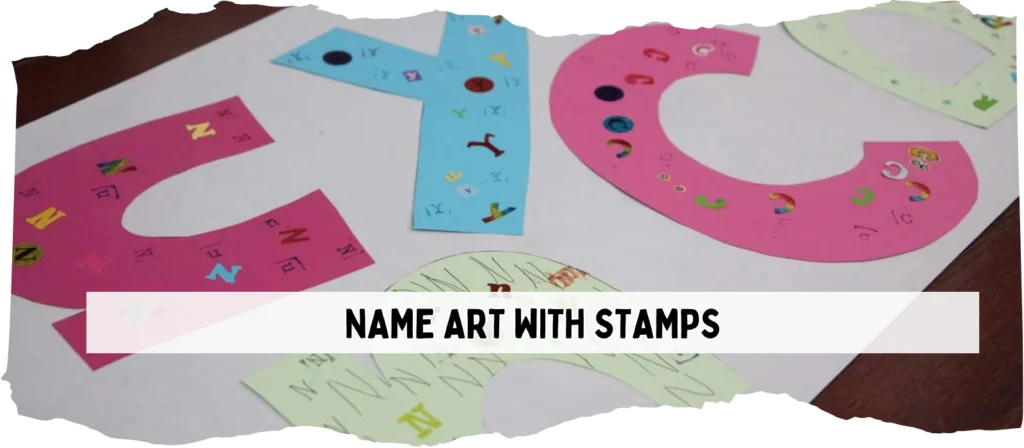
Age Range: 3–5 years
Materials Needed: Alphabet stamps, ink pads, construction paper, glue, decorating items
Learning Objectives:
- Promote name recognition and letter knowledge
- Foster creative expression
- Develop print awareness and early literacy
Incorporate phonics games around the finished name art to extend the learning.
6. All About Me Display Board
This all about me preschool project turns your classroom wall into a vibrant celebration of your students. Each child gets a section of the board to showcase their name, age, drawings, photos, favorite things, and a self-portrait. This collective project boosts visibility and builds classroom unity.
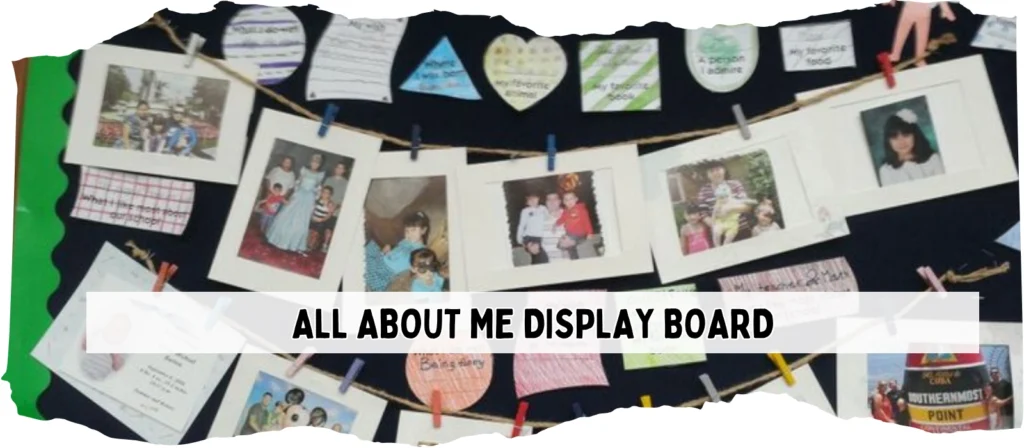
Age Range: 3–6 years
Materials Needed: Bulletin board paper, markers, glue, printed templates, crayons, family photos (optional)
Learning Objectives:
- Strengthen classroom identity and individual expression
- Build confidence through presentation
- Foster inclusion and social awareness
Teachers can rotate board themes weekly or monthly to keep the display dynamic and fresh, reinforcing the idea that every child matters.
7. My Favorite Things Booklet
Creating a personal booklet is a great way to engage children in a week-long all about me preschool project. Each page focuses on a different theme—favorite color, favorite food, favorite toy, and so on. This project encourages writing, drawing, and storytelling.
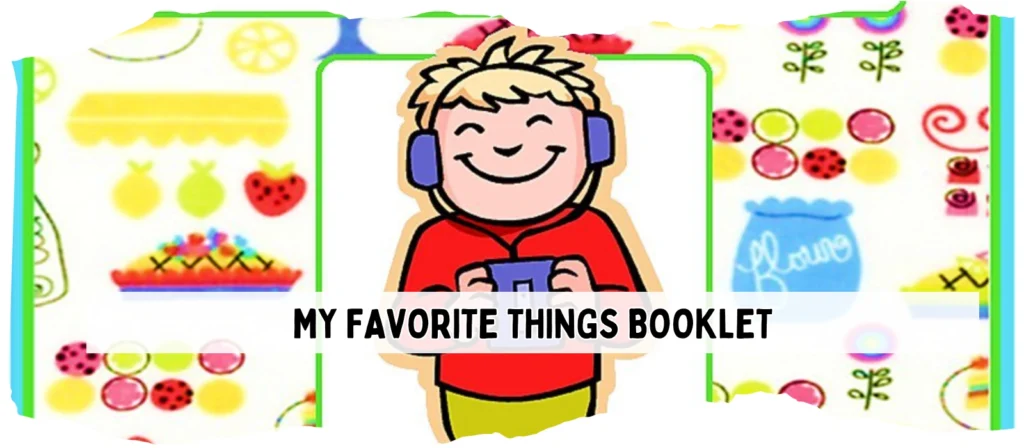
Age Range: 4–6 years
Materials Needed: Paper, stapler, crayons, printable booklet templates, markers
Learning Objectives:
- Practice self-expression through drawing and early writing
- Organize ideas into a sequence
- Develop storytelling skills
Bind the pages together and let children take the book home to share with their families, extending learning beyond the classroom.
8. Height Chart Project
Children love to measure themselves! In this interactive all about me preschool project, kids create personalized height charts using yarn, construction paper, and measuring tape. They can decorate their charts with photos or drawings of what they want to be when they grow up.
Age Range: 3–6 years
Materials Needed: Measuring tape, yarn, chart paper, glue, markers, photo printouts (optional)
Learning Objectives:
- Understand measurement and comparison
- Explore aspirations and future roles
- Promote fine motor and math readiness skills
Track height growth over the school year to create a lasting developmental record.
9. Cultural Identity Map
This rich all about me preschool project invites students to share where they come from—through maps, family traditions, flags, and languages. Teachers can adapt this activity to be as simple or detailed as appropriate.
Age Range: 4–6 years
Materials Needed: World map or printable country templates, crayons, stickers, family input letters
Learning Objectives:
- Celebrate cultural diversity and heritage
- Promote geography awareness
- Encourage family involvement
You can culminate the activity with a class “Culture Day” where children share songs, foods, or greetings from their backgrounds.
10. My Daily Life in Pictures
Children create a visual timeline of their day, from morning routines to bedtime. This all about me preschool project helps develop sequencing and time awareness while honoring children’s individual routines.
Age Range: 3–5 years
Materials Needed: Drawing paper, printable clock visuals, stickers, markers
Learning Objectives:
- Practice time-related vocabulary and sequencing
- Recognize and reflect on personal habits
- Build narrative thinking
Use this project as a springboard for learning about routines, calendars, and even early time-telling.
Creative All About Me Preschool Activities Beyond Art
While all about me preschool projects often include colorful art displays and individual posters, there’s a whole world of engaging, developmentally rich activities beyond the art table. These non-art activities expand on the same core goal—helping children explore and express who they are—through movement, conversation, discovery, and play.
All about me preschool projects don’t always require scissors and glue. They can take the form of games, performances, or physical exploration. The more diverse the activity types, the more opportunities every child has to connect with the material in a meaningful way. The following activities ensure that every child, regardless of their learning style, can engage with all about me preschool projects in a dynamic and memorable way.
1. All About Me Show and Tell
A classic and highly effective option, this activity gives each child the opportunity to bring a personal item from home and share it with the class. This might be a favorite toy, a family photo, or a drawing of their house. It’s an excellent verbal exercise and helps children feel seen and heard.
Benefits:
- Builds oral language and public speaking skills
- Encourages listening and turn-taking
- Strengthens classroom community through shared storytelling
2. All About Me Bingo
Create a simple bingo game where each square represents a personal trait or preference (e.g., “Has a pet cat,” “Loves pizza,” “Has a baby brother”). Children move around the room asking classmates questions to fill their boards. It’s a fun way to learn about each other.
Benefits:
- Develops social interaction and communication
- Encourages self-awareness and questioning
- Great for movement and energy release
Printable All About Me Bingo Cards
3. All About Me Sensory Bins
Fill sensory bins with objects that relate to each child’s preferences—favorite colors, textures, small symbolic items like toy foods, family figurines, or letters of their names. These bins can be customized weekly based on each child’s input.
Benefits:
- Supports sensory exploration and fine motor skills
- Personalizes sensory play based on individual identities
- Encourages quiet, reflective engagement
4. Dramatic Play: All About My Day
Set up a dramatic play center where children can role-play their daily routines: waking up, brushing teeth, going to school, having lunch. Include props like clocks, pretend toothbrushes, backpacks, and mini lunch trays.
Benefits:
- Enhances narrative skills and sequencing
- Reinforces daily structure and independence
- Builds empathy through imitation and role reversal
5. Name Recognition and Letter Hunts
Use foam letters, magnetic boards, or alphabet cards hidden around the room. Children find the letters of their names, arrange them in order, and decorate them. This works perfectly as part of all about me preschool projects with a literacy twist.
Benefits:
- Strengthens early literacy and letter recognition
- Personalizes learning with child’s own name
- Encourages movement and problem-solving
All About Me Preschool Book List (Best Read-Alouds)
Pairing all about me preschool projects with storytime is a fantastic way to reinforce identity-building themes through literature. Carefully selected books help preschoolers better understand themselves and their peers while supporting language development and listening skills. Below are some of the best all about me preschool books to read aloud in your classroom.
1. “I Like Myself!” by Karen Beaumont
A vibrant, rhythmic book that encourages children to celebrate themselves exactly as they are. It pairs perfectly with any all about me preschool project that promotes confidence and individuality.
Why it works:
- Reinforces positive self-image
- Uses fun language and bold illustrations to engage kids
- Ideal for 3–5 year olds
2. “All About Me” by DK Publishing
A simple yet effective board book that introduces basic concepts like name, age, and body parts. This is perfect for younger preschoolers or as a warm-up for more hands-on all about me preschool projects.
Why it works:
- Clear visuals and vocabulary for beginners
- Interactive prompts encourage participation
- Great for circle time or quiet reading centers
3. “The Family Book” by Todd Parr
This colorful and inclusive book explores different family structures and dynamics. It aligns seamlessly with all about me preschool projects like family trees or cultural identity maps.
Why it works:
- Celebrates family diversity
- Promotes acceptance and kindness
- Helpful conversation starter for inclusive classrooms
View The Family Book Teaching Guide
4. “Marvelous Me: Inside and Out” by Lisa Bullard
A relatable story about a boy named Alex who shares all the things that make him unique—from his appearance to his personality. This story fits beautifully alongside projects like self-portraits or favorite-things booklets.
Why it works:
- Highlights individuality and emotional awareness
- Encourages children to think about their inner traits
- Supports SEL and identity discussions
How to Use “All About Me” to Create a Positive Classroom Culture
All about me preschool projects don’t just help children learn about themselves—they lay the foundation for a thriving classroom community. When children see their names, faces, families, and ideas represented in the classroom, they begin to feel like they belong. This sense of belonging fuels confidence, improves behavior, and encourages cooperation.
Here’s how you can build a positive classroom culture using all about me preschool projects:
Celebrate Individuality
Create a “Spotlight Student” wall where each week a child shares their all about me materials, photos, and stories. Invite families to contribute. This gives children pride and helps others appreciate different backgrounds.
Use Projects as Communication Tools
Teachers can use completed all about me preschool projects to learn how to connect with each child. Does a student love animals? Add animal-themed books to the reading nook. Do they talk a lot about their sibling? Let them draw pictures of home life.
Encourage Peer Respect
Display everyone’s work equally and facilitate small group conversations where kids share their all about me crafts. Build empathy by guiding discussions about similarities and differences: “Who else has a pet?” “Who lives with grandparents?”
Reinforce Through Routine
Make time each morning for personal check-ins inspired by all about me themes. Ask questions like “What’s something you’re proud of today?” or “Who helped you yesterday?” These routines deepen connection and emotional growth.
All about me preschool projects are much more than one-time activities—they’re the heartbeat of a classroom culture built on respect, connection, and joy.
Recommended Materials for All About Me Projects (Supplies List)
Running successful all about me preschool projects requires thoughtful preparation and the right materials. While many activities rely on paper, crayons, and glue, enhancing the experience with well-chosen tools and furniture can elevate learning and classroom engagement.
Here’s a curated list of essential materials that support a wide range of all about me preschool projects:
1. Basic Art Supplies
- Washable markers, crayons, watercolor paints
- Blunt-tip scissors and glue sticks
- Pre-cut templates (faces, trees, handprints)
These core tools make it easy for young learners to express their individuality through art safely and independently.
2. Writing and Literacy Tools
- Name tracing sheets and alphabet stamps
- Dry erase boards for daily self-expression
- Laminated “All About Me” prompt cards
These resources support literacy-focused all about me preschool projects and reinforce name recognition, storytelling, and early writing.
3. Family and Culture Materials
- Multicultural crayons and skin-tone paper
- Family photo frames and cultural flag stickers
- Globes and maps for origin-based discussions
They allow children to proudly share who they are and where they come from—ideal for family tree, cultural map, or diversity-focused projects.
4. Classroom Furniture Essentials
- Low-height art tables and storage carts
- Display boards or rotating gallery walls
- Sensory tables and dramatic play centers
Furnishings from XIHA Furniture are perfect for organizing and showcasing all about me preschool projects. With child-safe materials, flexible designs, and international certifications, our furniture helps create spaces where identity-building activities thrive.
Explore XIHA’s preschool furniture collection
5. Portfolios and Documentation Tools
- Clear folders for student booklets
- Mobile carts for organizing worksheets
- Digital tablets or cameras to document student work
Preserving and displaying children’s work reinforces pride and makes assessment easier for educators.
Every material and setting decision should be intentional—designed to make each child’s unique story visible, respected, and celebrated in your classroom.
Why All About Me Projects Are Crucial for Preschool Self-Identity Development
At the heart of early childhood education is the goal of helping children understand who they are and how they relate to the world around them. All about me preschool projects provide the ideal structure for this identity-building work—serving as tools to help children recognize their own strengths, preferences, and emotional experiences.
According to a 2021 article published in Early Childhood Research Quarterly, self-concept development begins as early as age 3, and is most effectively supported through guided self-expression and social interaction. All about me preschool projects offer precisely this—creative and conversational outlets where children talk about their families, draw their emotions, and describe their dreams.
Neuroscience also supports this approach. A 2020 study published in Frontiers in Psychology demonstrated that identity-centered tasks activate brain regions associated with empathy, narrative memory, and emotional regulation in children aged 3–6. These findings affirm what many educators already know from experience: giving children time and space to reflect on themselves helps them develop a healthier sense of self—and deeper compassion for others.
The SEL (Social and Emotional Learning) framework promoted by CASEL (Collaborative for Academic, Social, and Emotional Learning) explicitly recommends identity exploration as a critical first step in preschool-level emotional development. All about me preschool projects align with these best practices and support all five core SEL competencies: self-awareness, self-management, social awareness, relationship skills, and responsible decision-making.
When children are invited to explore who they are in an intentional, supported way, they develop resilience, empathy, and pride. All about me preschool projects aren’t just cute crafts—they are evidence-based vehicles for emotional growth and lifelong confidence.
Common Mistakes to Avoid in Planning All About Me Preschool Projects
Even with the best intentions, some all about me preschool projects fall short due to avoidable planning pitfalls. These mistakes can reduce engagement, limit learning, or unintentionally exclude certain children. Here are the most common issues—and how to avoid them:
1. Using Generic, One-Size-Fits-All Worksheets
While printables are useful, relying solely on standardized templates can restrict creativity and personal connection. Children should be encouraged to express themselves in their own ways, not just fill in the blanks.
Solution: Offer open-ended options and provide diverse materials. Let children choose drawing, collage, storytelling, or even oral sharing formats for their all about me preschool projects.
2. Ignoring Cultural Diversity
Some projects may unintentionally assume all children have the same family structure, holidays, or daily routines. This can alienate students from diverse backgrounds.
Solution: Use inclusive language and examples. Allow children to describe family and cultural traditions in their own terms. Highlight books and visuals that reflect different communities.
3. Overloading Children with Too Much at Once
Trying to complete five or more all about me preschool projects in one week can overwhelm young learners. It may also limit their opportunity to reflect on each activity meaningfully.
Solution: Spread out projects over multiple weeks and revisit them. Treat all about me themes as a recurring part of your curriculum, not just a one-time activity.
4. Skipping Parent Involvement
Leaving families out of the process misses a rich opportunity to deepen learning. Parents and caregivers can offer valuable insight into each child’s identity.
Solution: Send home brief questionnaires, ask for family photos, or invite caregivers to participate in “All About Me Day.”
5. Forgetting to Display and Celebrate the Work
If finished projects end up in a drawer or pile, children may feel their efforts weren’t valued.
Solution: Showcase each child’s all about me preschool project proudly in the classroom. Rotate displays and make time for peer appreciation and sharing sessions.
By avoiding these missteps, teachers can ensure that all about me preschool projects are impactful, inclusive, and memorable experiences for every student.
Classroom Display Board & Portfolio Ideas for All About Me Projects
Creating a space to celebrate and revisit all about me preschool projects reinforces children’s pride and classroom connection. A dedicated display board or portfolio area transforms individual work into a collective classroom identity—and provides daily inspiration for further conversation and learning.
1. All About Me Wall Display
Dedicate a large bulletin board to rotating student profiles. Each child can display their name art, self-portrait, and a family photo. Adding student quotes about what makes them special helps personalize the area and encourages peer appreciation.
Tip: Use color-coded backgrounds or decorative borders for different themes like “My Family,” “My Favorites,” or “When I Grow Up.”
2. Portable Project Portfolios
Provide each child with a labeled folder or clear binder to store their ongoing all about me preschool projects. These make it easy to revisit work, reflect on growth, and share with families during conferences or celebrations.
Bonus: Add a “reflection page” after each activity where children can explain what they created and why.
3. Student Gallery Corners
Use lightweight frames or hanging clips to set up a rotating “gallery wall” that features two to three students each week. Include a short description, the child’s name, and even audio recordings if using a digital tool.
4. Dramatic Play Area Tie-Ins
Display completed self-portraits or family drawings in the pretend kitchen or reading area to make children feel more at home. When students see themselves represented in classroom environments, it boosts belonging.
5. Furniture That Supports Showcasing Work
Use display boards, easels, and low-level shelving units like those from XIHA Furniture to present projects at child’s-eye level. These fixtures allow for frequent rotation and easy student access.
XIHA’s solutions are built for both beauty and durability—perfect for bringing your classroom’s creativity to life.
View our display furniture collection
Conclusion
All about me preschool projects are more than just the first-week icebreakers—they’re the foundation of identity development, emotional growth, and classroom unity. From art-based self-portraits to thoughtful printables and storytelling games, these activities create safe spaces where every child can feel seen, valued, and proud of who they are.
At XIHA Furniture, we understand how important the right learning environment is. Our high-quality, kid-friendly preschool furniture supports educators in bringing these projects to life—on the wall, at the table, or through dramatic play. Let’s help children discover themselves one meaningful project at a time.



